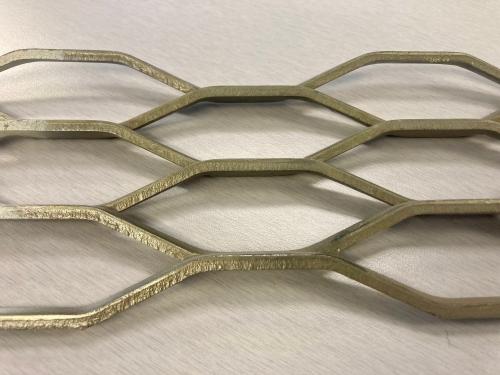Expanded metal exhibits versatility not only in its applications but also in the range of materials employed in its manufacturing. The choice of material significantly influences the performance, durability, and aesthetic qualities of the expanded metal product.
Materials Used in Expanded Metal
- Aluminum: Aluminum is a popular choice for expanded metal due to its combination of strength, lightweight nature, and corrosion resistance. This material is created by cutting and stretching aluminum sheets into a mesh, forming a pattern of diamond-shaped openings. The expanded metal maintains the integrity and rigidity of the aluminum while increasing its surface area and reducing its weight. This makes it ideal for applications in construction, automotive, aerospace, and architectural design, where both durability and ease of handling are critical. Additionally, aluminum's natural resistance to oxidation ensures longevity and minimal maintenance, making it a cost-effective solution for various industrial and commercial uses.
- Stainless: Stainless steel is highly favored for expanded metal applications due to its exceptional durability, strength, and resistance to corrosion. The process involves cutting and stretching stainless steel sheets to create a mesh pattern of diamond-shaped openings, which enhances the material's surface area and maintains its structural integrity while reducing weight. This robust and versatile material is ideal for demanding environments, such as in construction, chemical processing, food and beverage industries, and architectural projects. Stainless steel's ability to withstand harsh conditions and its low maintenance requirements make it a reliable choice for both functional and aesthetic purposes. Furthermore, its sleek, modern appearance is often utilized in design elements, offering a combination of practicality and visual appeal.
- Carbon: Carbon steel is a widely utilized material for expanded metal due to its high strength, durability, and cost-effectiveness. The production process involves cutting and stretching carbon steel sheets into a mesh with diamond-shaped openings, which enhances the material's structural integrity while maintaining its weight efficiency. Carbon steel expanded metal is particularly favored in industrial and construction applications where robustness and longevity are critical. Its ability to withstand heavy loads and resist impact makes it suitable for platforms, walkways, and security screens. Although carbon steel is prone to rust, it can be treated with coatings or galvanization to enhance its corrosion resistance. This combination of strength, versatility, and affordability makes carbon steel an excellent choice for a wide range of applications, from heavy-duty industrial uses to architectural designs.
- Galvanized: Galvanized steel is an excellent choice for expanded metal applications due to its enhanced durability and superior resistance to corrosion. This material is produced by coating carbon steel sheets with a layer of zinc, which acts as a protective barrier against rust and environmental damage. The process of creating expanded metal from galvanized steel involves cutting and stretching the sheets into a mesh with diamond-shaped openings, preserving the material's strength while reducing its weight. This makes galvanized steel expanded metal ideal for outdoor and industrial applications, such as fencing, grating, and walkways, where exposure to moisture and harsh conditions is common. Its combination of toughness, longevity, and low maintenance requirements ensures reliable performance over time, making it a cost-effective solution for both structural and decorative purposes.
Common materials include steel, aluminum, stainless steel, and various alloys, each offering distinct advantages based on the intended use. Steel, with its robustness and affordability, is a popular choice for industrial applications, where strength and durability are paramount. On the other hand, aluminum is favored for its lightweight properties, corrosion resistance, and suitability for architectural and decorative purposes. Stainless steel, known for its corrosion resistance and aesthetic appeal, finds applications in both industrial and architectural settings.
The material selection for expanded metal extends beyond the conventional metals, with manufacturers experimenting with innovative alloys to meet specific requirements. These may include materials with enhanced resistance to extreme temperatures, chemicals, or atmospheric conditions. The careful consideration of material properties ensures that expanded metal can cater to diverse industries, from heavy-duty industrial applications to delicate architectural designs.
As technology advances and new materials emerge, the landscape of expanded metal materials continues to evolve, offering designers and engineers an ever-expanding palette to work with in their projects. This dynamic aspect of material selection contributes to the adaptability and continual relevance of expanded metal in various sectors.

